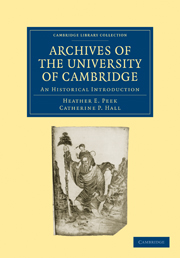1 - The Medieval Archives
Published online by Cambridge University Press: 07 September 2010
Summary
The earliest archives of the university, mainly charters of privilege from kings and bishops, were kept with the other valuables belonging to the university in the Common Chest. This practice was general, both for private persons and corporate bodies of all kinds, and indeed the statutes of nearly every medieval college in Oxford and Cambridge, and of the universities themselves, enjoin the safekeeping in chests of the common seal, the plate, the charters, and other important documents. The chests in which these precious articles were deposited were made of stout oak planks from two to three inches thick, bound with iron bands and secured by locks and padlocks of different wards, so as to require the presence of several officials at the same time to open them. One such chest, dating from the later Middle Ages, is still in the registrar's room and has five different locks. The keys were held by the chancellor (or vice-chancellor), the two proctors, and two non-regent masters chosen for this purpose. Regulations for the election of these masters, for opening the Common Chest and for keeping an account of the contents were laid down in the ancient ‘StatutaV The annual audit was held ‘within 8 days of the feast of St Dionysius’ (9 October) and at this an indenture was drawn up between the outgoing and incoming officers, enumerating the contents of the Chest. The outgoing proctors kept one half as their acquittance and the other was deposited in the Chest.
- Type
- Chapter
- Information
- Archives of the University of CambridgeAn Historical Introduction, pp. 1 - 6Publisher: Cambridge University PressPrint publication year: 1963First published in: 1962



